Caribbean-style pan-seared red snapper filet served with Haitian-inspired tomato-based thyme-infused Creole sauce with a kick of scotch bonnet pepper and roasted baby vegetables of baby zucchini, baby potato medley, and Campari tomatoes for an incredible snapper dish with Creole sauce.

Table of Contents
Jump to:
Haitian-Creole Flavor
Get ready to experience a taste of the Caribbean with this Seared Snapper in Spicy Creole Sauce and Roasted Vegetables. This dish features a perfectly pan-seared red snapper filet, showcasing the vibrant flavors of the islands.
The snapper is served with a Haitian-inspired, tomato-based Creole sauce infused with fresh thyme and the bold heat of scotch bonnet pepper, creating a delicious and spicy flavor profile. Complementing the fish are roasted baby vegetables, such as baby zucchini, a colorful medley of baby potatoes, and sweet Campari tomatoes, all adding layers of texture and taste.
Sos
The cuisine of Haiti is a rich blend of influences from French, African, Spanish, and Indigenous Taino cooking traditions. This is especially evident in the beloved Creole sauce, "Sos." The French contribution of aromatic herbs, combined with African spice blends and Spanish tomato-based sauces, creates a unique, flavorful, and aromatic Haitian Creole sauce.
This sauce forms the base of many Haitian dishes, providing a rich and spicy complement to various proteins.
Snapper
Red snapper is usually cultivated and fished in the warm waters of the Gulf of Mexico, the Caribbean Sea, and the western Atlantic Ocean, from North Carolina to northern South America. This fish is a favorite among Haitians and is celebrated for its versatility and flavor. It can be served in countless ways, from whole roasted and grilled to fried, pan-seared, and stewed, always allowing its delicate yet distinct taste to shine through.
These culinary influences and my deep-rooted love for snapper inspired the creation of the Seared Snapper with Spicy Creole Sauce and Roasted Vegetables recipe, which blends traditional flavors with a touch of modern flair to honor and elevate Haitian culinary heritage.
Scotch Bonnet & Pikliz
The scotch bonnet pepper, native to the Caribbean, has a rich history and plays an important role in the region's cuisine, particularly in Haitian food. Known for its intense heat and distinct fruity flavor, this pepper is a staple in many Caribbean dishes, adding both spice and complexity.
In Haitian cuisine, the scotch bonnet is a key ingredient in the beloved Pikliz, a spicy pickled vegetable relish made with cabbage, carrots, bell peppers, and vinegar. Pikliz provides a fiery, tangy kick that enhances various dishes, from grilled meats to fried plantains.
The vibrant flavors of the scotch bonnet and its cultural significance in dishes like Pikliz inspired me to incorporate it into my Seared Snapper with Spicy Creole Sauce and Roasted Vegetables recipe. I hope this dish brings a taste of Haitian cuisine to your table, allowing you to savor the rich culinary heritage of the Caribbean through this amazing dinner recipe.
Learn more about Haitian cuisine with inspired recipes:
Best Air Fryer Caribbean Style Citrus Chicken Wings: This page explores the vibrant flavors of Haitian-inspired cooking, such as scotch bonnet peppers and other traditional spices, to create a delicious and flavorful dish.
Air Fryer Chicken Thighs, Loaded Plantain Fries, and Pepper Slaw: This recipe page discusses the influence of Haitian cuisine through the use of traditional ingredients and cooking methods, such as pepper slaw made with habanero or scotch bonnet peppers, reflecting the bold and spicy flavors characteristic of Haitian food.
Papaya Rum Coconut Ninja CREAMi: This page not only offers a refreshing dessert recipe inspired by Haitian "Jus Papay" but also provides insights into the historical and cultural influences that shape Haitian cuisine, including the blend of French, African, and indigenous Taino culinary traditions.

Are you looking for Authentic Haitian Recipes? Check out Love for Haitian Food and Savory Thoughts.
Creole and Caribbean-Inspired Recipes
- Spicy Creole Shrimp and White Cheddar Cheese Risotto
- Pepper Fish Yam Stew
- Curried Ground Turkey, Vegetables & Olives
- Blackened Trout with Chorizo Beans and Garlic Broccoli
- Curry Lentil Turkey Stew
Ingredients
To prepare this delicious Seared Snapper with Spicy Creole Sauce and Roasted Vegetables, start by roasting a medley of baby potatoes, baby zucchini, and Campari tomatoes on a baking sheet at 375 degrees Fahrenheit for 25-30 minutes until tender and caramelized, stirring halfway through.
Meanwhile, prepare the Creole sauce by heating olive oil in a saucepan over medium heat, then sweating garlic and thyme until tender. Add crushed fire-roasted tomatoes, low-sodium broth, and a pierced scotch bonnet pepper, and be cautious when washing your hands immediately after handling the pepper.
Incorporate sliced red onions and red bell pepper, cover, and simmer for 15-20 minutes until the sauce thickens, seasoning with salt, pepper, and lime juice. For the Red Snapper filets, pat them dry, season with salt and pepper, and cook in a hot skillet with olive oil, starting skin-side down until crispy, then flipping to finish cooking.
To serve, spoon the Creole sauce onto plates, layer the roasted vegetables on top, place the seared snapper filets, and finish with the cooked onions and bell pepper.
Culinary Glossary
This section provides concise definitions of key ingredients and techniques to enhance understanding and improve cooking skills related to this recipe.
- Scotch Bonnet Pepper - A scotch bonnet pepper is a small, extremely hot chili pepper commonly used in Caribbean cuisine to add heat and flavor.
- Thyme Springs - Thyme is a staple in Haitian cuisine, providing a fragrant, earthy flavor that enhances many traditional dishes.
- Carmalization - Important in pan-searing, where the browning of the meat occurs and enhances the flavor, also known as the Maillard Reaction.
- Sliced Red Onions and Bell Pepper - Traditionally, these are in Haitian stewed foods in Creole sauce or broth base sauces.
See the recipe card for quantities below.



My Rating: ⭐⭐⭐⭐⭐
Purchased: Many Years Ago, lol
Update: 08/19/24
My Review: Pyrex is a household staple in America, and you can't go wrong with it. The Pyrex Prepware 2-Cup Glass Measuring Cup features easy-to-read double-sided measurements in both metrics and ounces, and it's made of tempered glass, so it's microwave-safe—perfect for melting butter. The sturdy, molded handle won’t break, and the spout allows for easy pouring. Simple, reliable, and built to last.
Update 01/02/24: I recently bought the Pyrex 4-Cup Glass Measuring Cup, which is great for measuring broth for soups; plus, you can make batter right in it.
Instructions
Follow the instructions and cooking tips below using the step-by-step picture guide.

All the vegetables are cut uniformly to cook evenly.

Place the vegetables cut side down, allowing for caramelization.
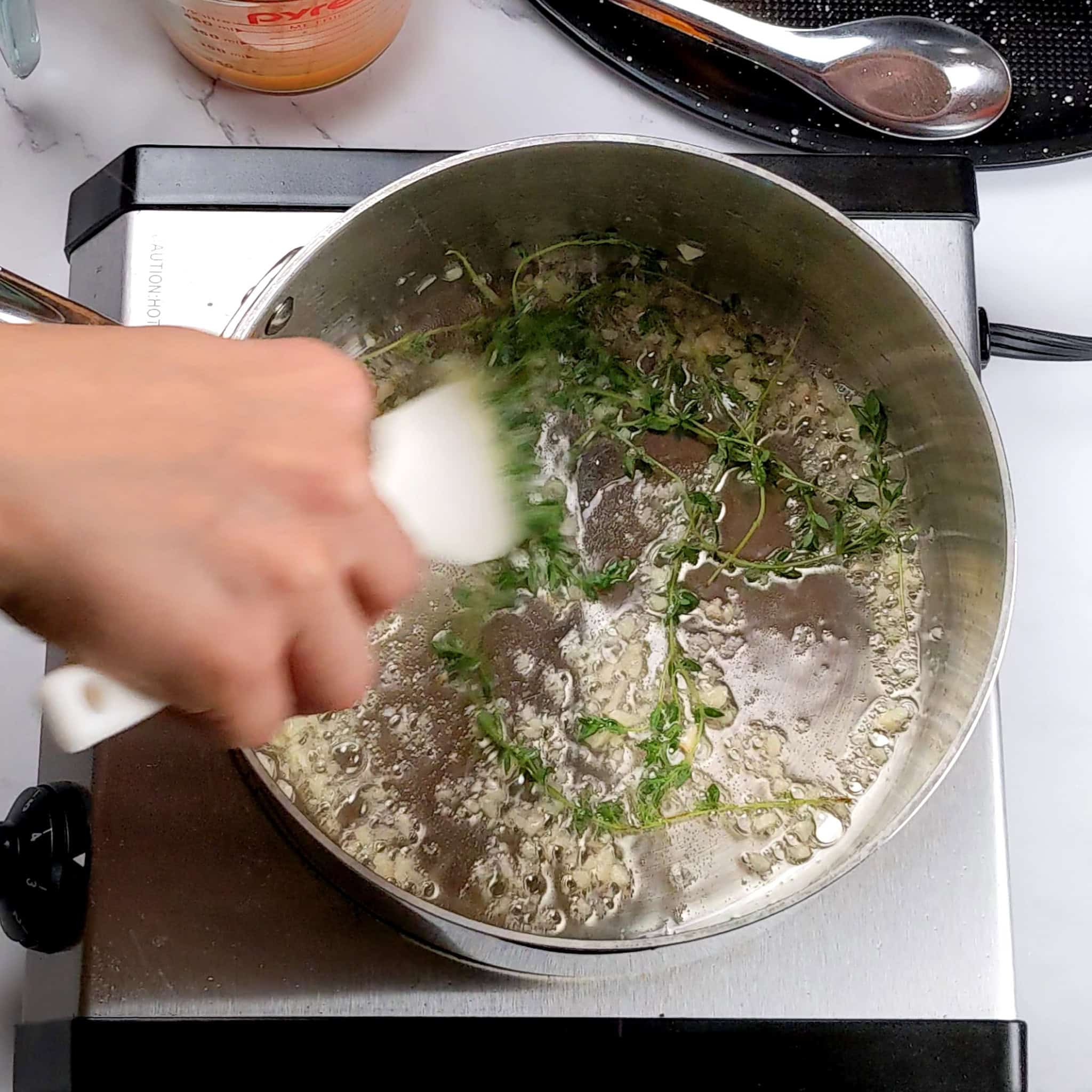
The garlic and thyme taste sweat together to allow the flavors to meld with the oil, building the first layer of flavor for the sauce.

Occasionally, stirring helps prevent burnt bits at the bottom and cooking on low heat to simmer.

The scotch bonnet pepper is added whole since it is very hot; a pierce is all needed before adding it to the pot.

The onions are added first since you want these to be cooked more than the red bell peppers.
My Rating: ⭐⭐⭐⭐⭐
Purchased: 06/06/23
My Review: As a chef with over two decades of experience relying on All-Clad, their D3 Stainless 3-quart saucepan is a kitchen workhorse. The sturdy 3-ply construction ensures even heat distribution for perfect simmering, searing, and everything in between. It's a breeze to clean, goes effortlessly from stovetop to oven, and consistently delivers exceptional results for rice, soups, sauces, and more. This saucepan is a worthy investment if you're looking for durable, versatile, and American-made cookware.

Pat dry the fish before seasoning, removing excess moisture to ensure proper searing.
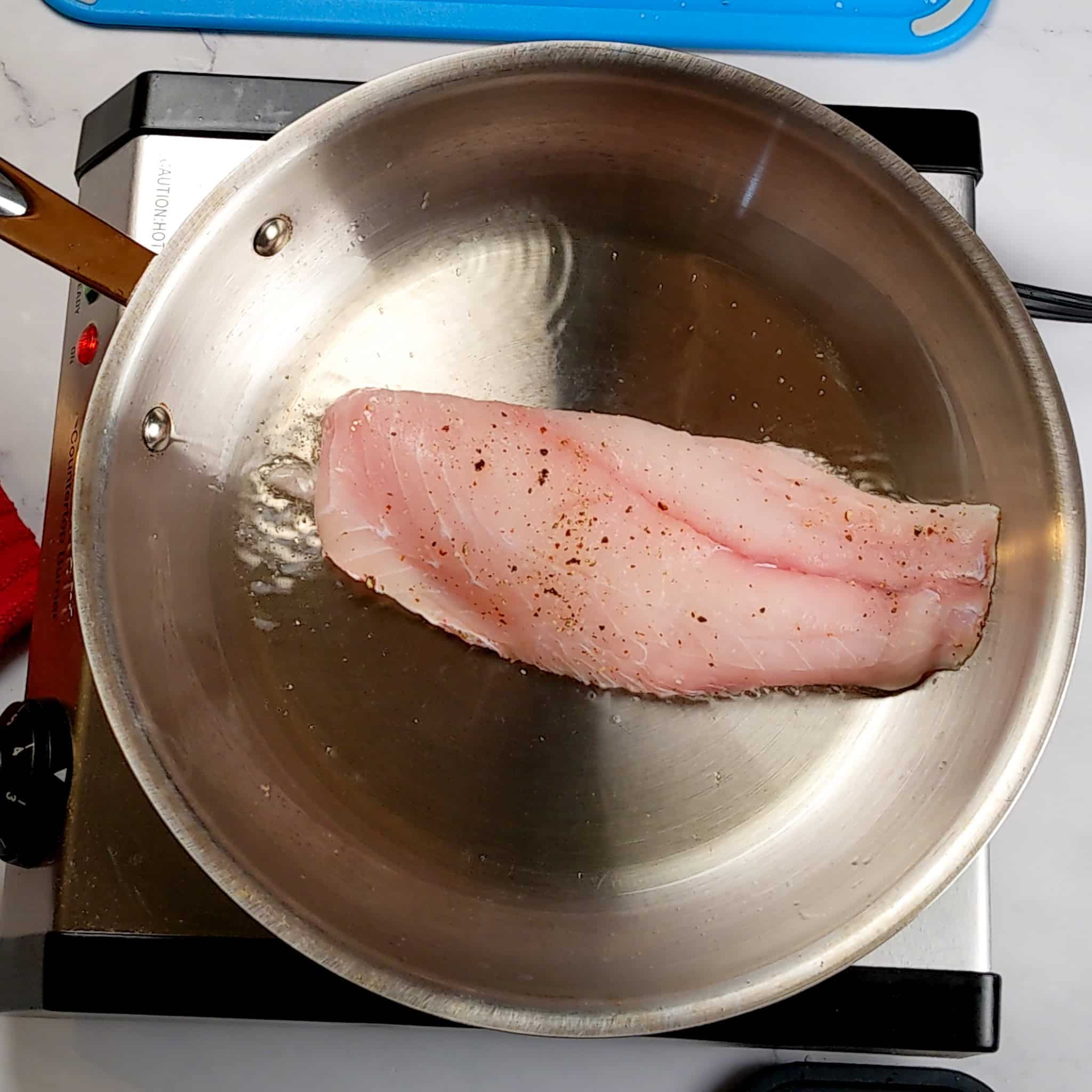
Searing involves cooking the fish at high temperatures to create a browned, flavorful crust.
Rating: ⭐️⭐️⭐️⭐️⭐️
Purchased: 03/26/2023
My Review: I absolutely love this Plastic Cutting Board Set of 4 with a Storage Stand! The color-coded boards are a lifesaver for preventing cross-contamination, especially when I’m switching between meats and veggies. The plastic is super sturdy, so I don’t have to worry about it flexing while I’m chopping. What really stands out for me is how easy they are to use—after chopping, I slide everything straight into the pot, which keeps my kitchen clean and saves time. Cleanup is such a breeze, too; they go right into the dishwasher without any warping. Plus, the storage stand keeps everything neat and organized. These boards have made cooking so much easier and more enjoyable!

Slits were made in the fish to prevent curling during this rapid cooking process, and gently pressing down with a fish spatula also helps prevent it as well.
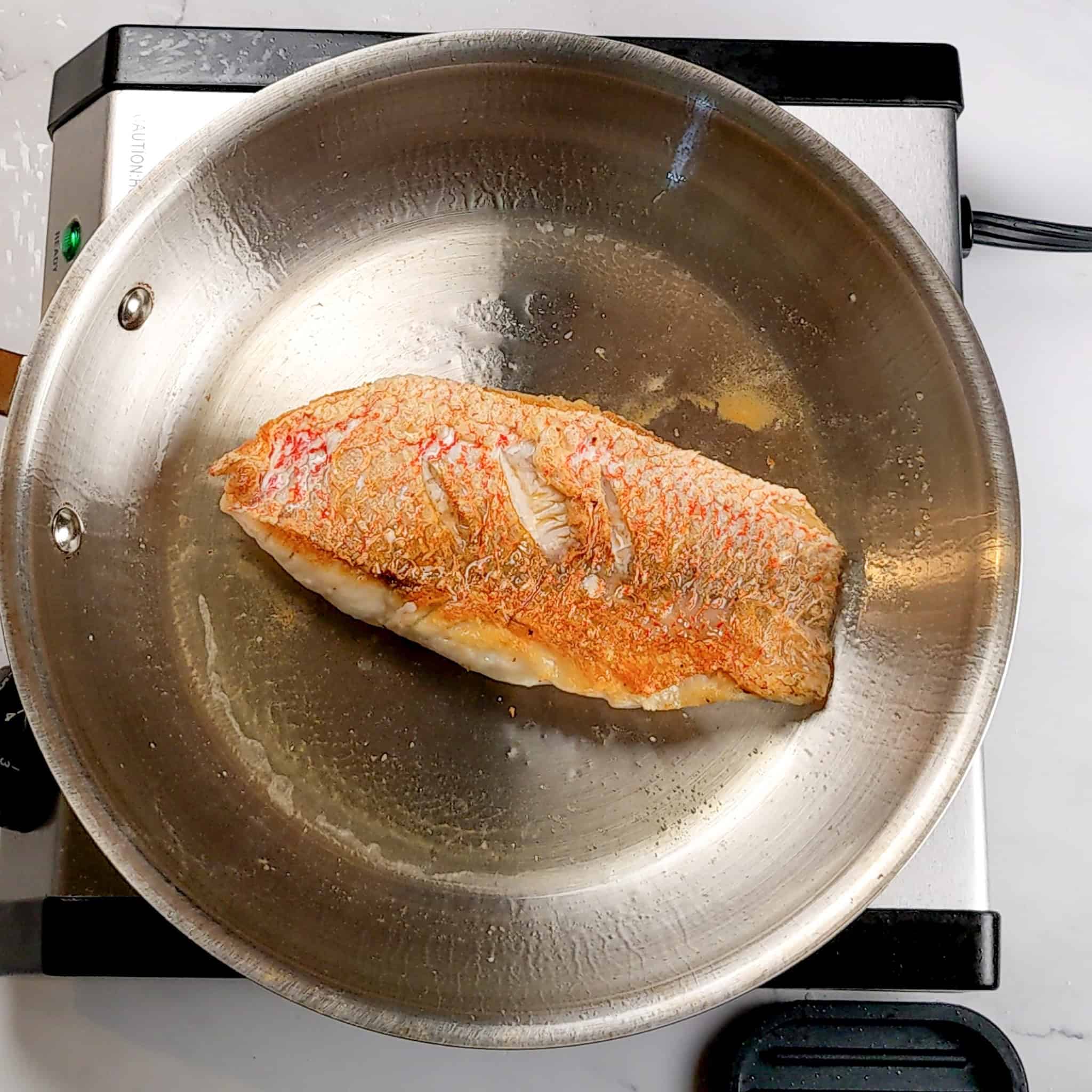
The cooked fish should be opaque, fully cooked, and no longer translucent. It should be caramelized to a golden brown, creating a rich, sweet, savory flavor.


The tomatoes will caramelize and puff, creating a very interesting presentation.

Before serving the sauce, make sure to remove the pepper since it can potentially burst, creating a very hot sauce.

The sauce should be slightly thickened but pourable. Add a tablespoon of what at a time to adjust the sauce if needed.
Substitutions
Dairy-Free
- This Snapper with Creole Sauce recipe is dairy-free.
Gluten-Free
- This dish is also gluten-free.
Vegetarian
- Red Snapper Filets - Visit Plant-Based Passport: Vegan Tofu Fish and Loving It Vegan: Vegan Fish recipes for inspiration.
- Low Sodium Fish Broth - As mentioned in the recipe, this can be substituted with vegetable broth.
Convenience
- Baby Potatoes - If you are going to use large potatoes, cut them into small uniform sizes, and it is best to use waxy potatoes like Yukon gold or red potatoes.
- Campari Tomatoes - These are chosen for the great balance of sweetness and acidity. But you can use cherry, grape, or plum tomatoes.
- Fresh Thyme - Substitute with dried thyme, using 1 part dried to 3 part fresh when converting.
- Red Onion - You can easily replace this with white or yellow onions or even shallots.
- Minced Garlic - Use garlic paste.
- Red Snapper Filets - Use other substitutes for snapper, including grouper, tilapia, sea bass, or cod, as they share a similar mild flavor and flaky texture.
- Scotch Bonner Pepper - If you have habanero pepper, you can use it. It will slightly change the flavor characteristic since it tends to be on the sweeter side, but it is still a good substitute.
- Crushed Fire-Roasted Tomatoes - You can substitute this with tomato paste but in a smaller amount. It will make the sauce thinner since you have to add more broth. Add charred tomatoes, but this will have to cook longer to remove some of the acidity.
Change Heat Level - Modify the recipe's heat level to your liking and learn more about the Scoville Scale and Chili Pairings.
Variations
- White Wine - Add a splash of white wine to boost flavor. Add it to the tomato sauce, and do not cover it yet; allow the alcohol to evaporate, then cover it to simmer. I suggest using Sauvignon Blanc, a great wine with spicy fish dishes.

Equipment
- Mixing Bowls - You'll need a set of mixing bowls to toss and season your vegetables. I used the Pyrex Glass Mixing Bowls, but stainless steel or melamine options work just as well for this task.
- Baking Sheet Pan - A sturdy sheet pan is essential for roasting. I used the Nordic Ware Natural Aluminum Commercial Baker's Half Sheet, though any rimmed half-sheet pan you have on hand should work fine.
- Silicone Liner - To keep things from sticking and make cleanup easier, I lined the pan with a silicone baking mat from Amazon Basics. Parchment paper is a good backup if you don’t have one.
- Saucepan - A small to medium saucepan is needed for the Creole sauce. I used the 3-Quart All-Clad D3 Stainless Steel Sauce Pan, but any heavy-bottomed saucepan will do as long as it holds heat evenly.
- Paper Towels - You’ll want to pat the fish dry to get that golden sear—just grab a few paper towels or a clean kitchen towel for this step.
- Large Skillet - For searing the fish, I used the 10-Inch All-Clad D3 Fry Pan with Lid. A cast iron skillet or any stainless steel pan with a good sear will also work.
- Fish Spatula - To flip the fish without tearing it, I used the flexible and durable OXO Good Grips Stainless Steel Fish Turner. If you don’t have one, a thin metal spatula can be a solid stand-in.
Kitchen Must Haves - Find other tools I use here.
Storage
- Refrigerator - To store in the fridge, place the sauce, vegetables, and fish in a shallow 2-inch container to cool down quickly. Then, store it in an airtight container. The meal will last up to two days; the fish or if it is combined, but if the sauce and vegetables are separated, the vegetables are three days, and the sauce is four.
- Freezer - Follow the refrigeration process mentioned above. Then, place it in the freezer in a labeled, airtight container.

For meal prep, I typically use Freshware Meal Prep Containers.
Airtight Food Containers
I interchange glass food storage containers with plastic clipping lids or wooden push-ins. I always suggest glass storage containers because they can be microwaved, they hold food without staining, and the glass keeps the food at a more stable temperature, keeping it fresher and longer.
Try the OXO Good Grips Smart Seal Glass Rectangle Food Storage Containers or the Pyrex Freshlock Glass Food Storage Containers.

Cooking Tips
Your Cooking Tips Resource Guide - Become a better home cook with tips to help you cook more efficiently on the Cook's Notebook tab Learn more about prepping fish.
- Scotch Bonnet Pepper - Handle scotch bonnet peppers with gloves and avoid touching your face, as their intense heat can irritate; always wash your hands thoroughly after handling. Learn more about prepping chili peppers here.
- Pan-Searing Fish - To prevent sticking when pan-searing fish in a stainless steel frying pan, ensure the pan and oil are hot before adding the fish, and avoid moving it until a crust has formed. Learn more about prepping fish here.
Frequently Asked Questions
Snapper is a saltwater fish known for its mild, sweet flavor and firm, flaky texture. It is commonly used in various cuisines, particularly Caribbean and Mediterranean dishes.
Different types of snapper fish include red snapper, yellowtail snapper, mangrove snapper, mutton snapper, and lane snapper, with red snapper being the most popular used.
Scotch bonnet peppers are extremely hot, ranging from 100,000 to 350,000 on the Scoville heat scale, which makes them significantly hotter than jalapeños.
Their intense heat is complemented by a fruity, slightly sweet flavor, making them a popular choice in Caribbean cuisine for adding spice and complexity. Learn more about the Scoville Scale.
To purchase seasonal baby vegetables, you can either visit local farmers' markets or check the seasonal produce section of your grocery store.
Look for fresh, vibrant, and firm vegetables like baby carrots, baby bell peppers, and baby eggplants to use as alternatives for baby zucchini, baby potatoes, and Campari tomatoes in the recipe.
Slice tomatoes (Beefsteak: ½-inch slices. Roma Tomatoes: halved horizontally. Cherry or Grap tomatoes - do not cut all at, roast whole). Then, heat the grilling basket on flames for about 1 minute.
Remove the basket and coat the grilling basket with a small amount of avocado oil (or another high smoke point oil of your choice, such as canola oil). Then, place the grilling basket back on the grill. Layer the tomatoes on the grilling basket.
Allow the heat to create blisters on the tomatoes' skin with slight fire marks across the tomatoes. Finally, remove from heat and use.
Slice tomatoes (Beefsteak: ½-inch slices. Roma Tomatoes: halved horizontally. Cherry or Grap tomatoes - do not cut all at, roast whole). Use the oven broiler setting (Preheat and Use at Medium Heat to 450 degrees Fahrenheit). Then, use a roasting rack and a sheet pan.
Next, layer out the tomato pieces with space in between each piece to prevent steaming in the broiling process. Steam will cause prevent charring and blistering. Allow the broil to create blisters and slight charing marks on the tomatoes.
Then, flip the tomato pieces or shake the pan for intact ones to broil the other side. Remove from heat and use.
Seafood Recipes
Looking for other seafood recipes like this? Try these:
- Healthy Haitian-Style Creole Spicy Shrimp Pasta
- Sesame Seed-Crusted Ahi Tuna with Spicy Sesame-Soy Sauce
- Grilled Shrimp Garlic Jalapeno Butter and Cilantro Lime Rice
- Spicy Cajun Shrimp Rice Bowl with Lemon Remoulade
Caribbean Recipes
Looking for other Caribbean recipes like this? Try these:
- Green Seasoning Recipe | Epis - Haitian Style
- Habanero Tamarind Glaze | Sweet, Spicy, and Tangy
- Creamy Curry Chicken Gnocchi Soup | Caribbean Style
- Creole Tomato Sauce Recipe | Easy Spicy Haitian-Inspired
📖 Recipe
Seared Snapper Spicy Creole Sauce and Roasted Vegetables
Ingredients
Roasted Vegetables
- 1 pound baby potatoes halved
- 1 pound baby zucchini halved or quartered
- 8 Campari tomatoes halved
- 2 tablespoons olive oil
- 4 to 5 fresh thyme sprigs
- Salt and pepper to taste
Haitian-Inspired Scotch Bonnet Creole Sauce
- 2 tablespoons olive oil
- 1 red onion sliced into rings
- 2 cloves garlic minced
- 1 scotch bonnet pepper finely chopped (remove seeds for less heat)
- 1 red bell pepper thinly sliced
- 1 cup crushed fire-roasted tomatoes
- 4 to 5 fresh thyme sprigs
- ½ cup low-sodium fish or vegetable broth
- Salt and pepper to taste
- ½ lime juiced
Seared Snapper Filets
- 32 ounces snapper filets skin-on (4 filets)
- 2 tablespoons olive oil
- Salt and pepper to taste
Equipment
Instructions
- Save time in the kitchen: Read the instructions thoroughly, then gather and prep all your ingredients before cooking! Learn Prepping Tips.
- Prepare the Vegetables: Preheat the oven to 400 degrees Fahrenheit. Toss the baby potatoes, baby zucchini, and Campari tomatoes with olive oil, fresh thyme sprigs, salt, and pepper in a mixing bowl.
- Roast the Vegetables: Spread the vegetables in a single layer on a baking sheet pan with a silicone liner. Roast in the preheated oven for 25-30 minutes or until the vegetables are tender and slightly caramelized, stirring halfway through.
- Prepare the Creole Sauce: Heat the olive oil in a saucepan over medium heat. Sweat garlic and thyme until the garlic is tender. Add crushed tomatoes and broth. Pierce the scotch bonnet pepper with a knife and add to the sauce. Important: Ensure to wash your hands immediately after touching the pepper, and do not rub your eyes.
- Add sliced onions and then red bell pepper on top. Cover, bring to a simmer, and cook until softened about 15-20 minutes, stirring occasionally, until it thickens slightly. Season with salt and pepper to taste. Finally, finish with the juice of 1 lime, stir, and remove from heat. While the sauce simmers, prepare the fish.
- Prepare the Snapper: Pat the snapper filets dry with paper towels and season both sides with salt and pepper.
- Cook the Snapper: Heat the olive oil in a large skillet over medium-high heat. Place the snapper filets skin-side down in the skillet. Press down gently with a spatula to ensure the skin makes contact with the pan. Then, cook for about 3-4 minutes, or until the skin is crispy and the fish is nearly cooked through.
- Carefully flip the filets with a fish spatula and cook for another 1-2 minutes, or until the fish is opaque and cooked through.
- To Serve: Spoon only the Creole sauce on the bottom of the plate. Layout the vegetables on top of the sauce. Place the seared snapper filet on top. Finally, twist and top the cooked onions and bell pepper on top of the fish.
Video
Nutrition
Subscribe to My YouTube Channel
SUBSCRIBE: 👈To my YouTube Channel to Get Notifications of New Videos.
Have a Comment or Question?
If you have a question or comment about this recipe, please post it below. You will definitely get a quick response. It also helps our other readers to stay informed. Thanks!

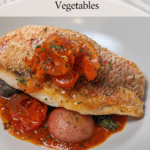


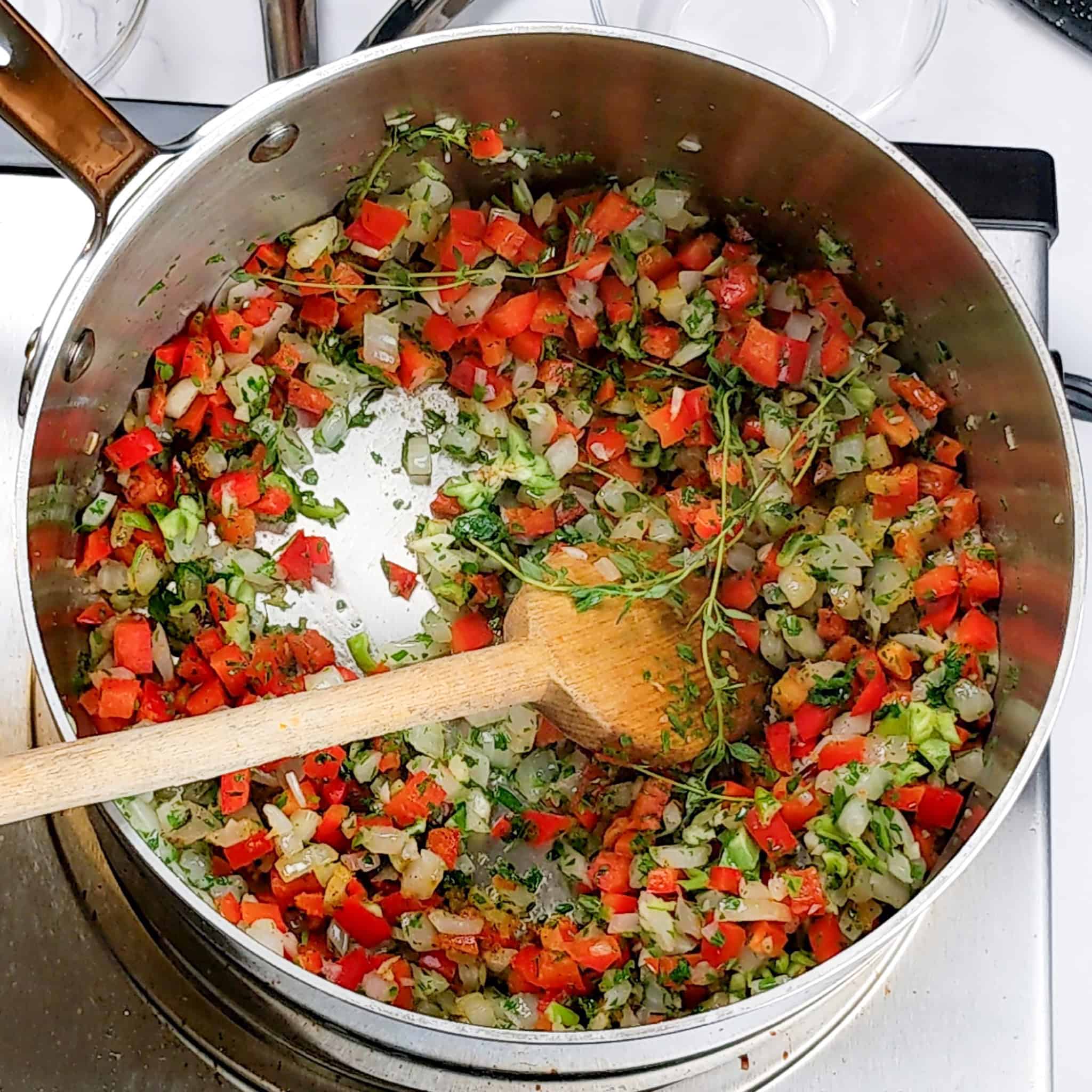



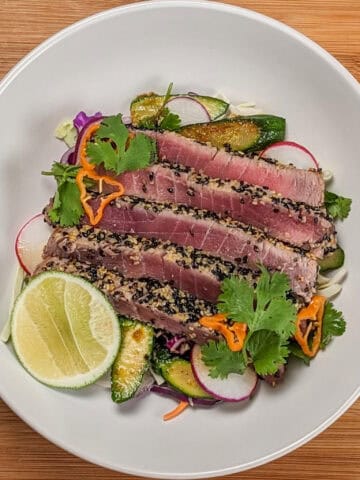




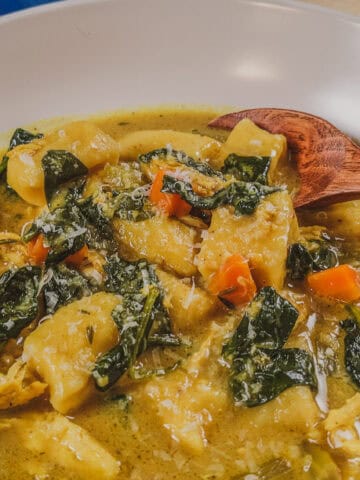



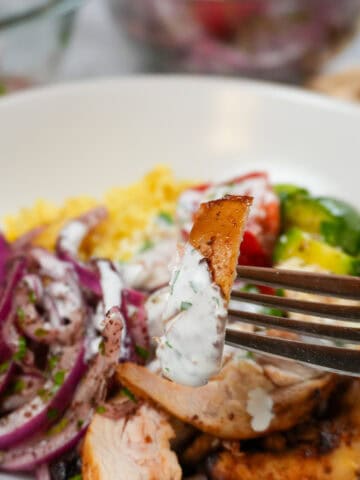


Leave a Reply